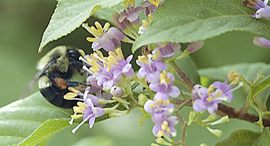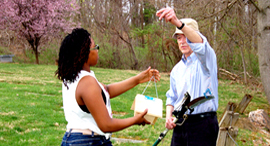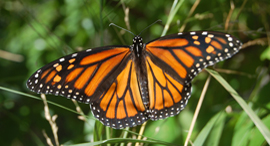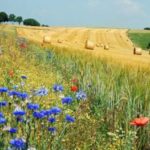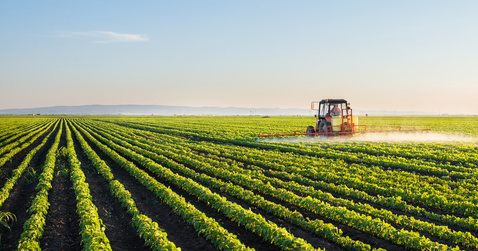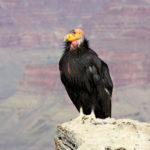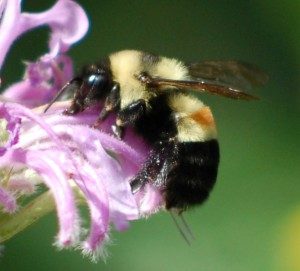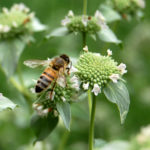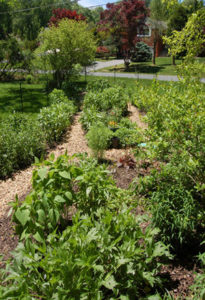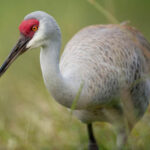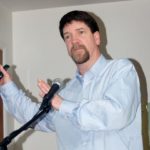An Alliance for Awareness
Providing information about issues relevant to Silent Spring and critical today.
Issues & Insights
The Wonder Contest in 2024
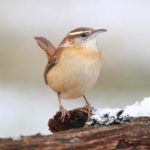 The Rachel Carson Intergenerational Sense of Wonder/Sense of the Wild Contest in 2024 is open for entries. Each entry needs to be from a team of at least two members from two different generations (a teacher and a student, a parent and a child, etc.). Click Here for Contest Details.
The Rachel Carson Intergenerational Sense of Wonder/Sense of the Wild Contest in 2024 is open for entries. Each entry needs to be from a team of at least two members from two different generations (a teacher and a student, a parent and a child, etc.). Click Here for Contest Details.
• • • • •
The Organic Link to Lower Cancer Risks And Sustainable Agriculture: A Report from RCLA
In a recently-published study scientists reported findings that “strongly suggest that an organic based diet could contribute to reducing cancer risks.”
In a 2017 scholarly book the editors recommended “a new framework for… effective, sustainable and environmentally compatible pest management” based on practices closely resembling the standards used in organic farming.
Greatly reducing chemical pesticide use for health and environmental reasons would be consistent with the message that Rachel Carson developed in Silent Spring and “A New Chapter to Silent Spring” This change is needed now more than ever.
Click here for important details in the complete text of The Organic Link to Lower Cancer Risks And Sustainable Agriculture: A Report From RCLA. Diana Post 11-23-18
• • • • •
Recent Triumphs for Science and Silent Spring
Posted 12-7-17
 Within the past year from two very different parts of the world news has come that two serious maladies (one in people and one in animals) transmitted by insects have been eliminated. In these cases applications of chemical insecticides were avoided or minimized.
Within the past year from two very different parts of the world news has come that two serious maladies (one in people and one in animals) transmitted by insects have been eliminated. In these cases applications of chemical insecticides were avoided or minimized.
One involved malaria in a country where past broadcast spraying of DDT had been widespread. In 2016, however, government officials of this island nation off the tip of India announced that a diversified approach had successfully eliminated the disease and their country was now malaria-free.
During 2017, in our own country a restricted outbreak of a dangerous disease afflicting domestic and wild animals was eliminated using a non-chemical strategy developed in the 1950s. The method remains as effective as when in Silent Spring Rachel Carson described it as: “a triumphant demonstration of the worth of scientific creativity, aided by thorough basic research, persistence and determination.” (Silent Spring, p. 280-281)
During this environmentally troubled holiday season such good news merits celebrating and sharing with friends, relatives and colleagues in the year ahead.
Click here for the full article
• • • • •
From DDT to Dicamba: Before and After Silent Spring
Posted 11-1-17
Summary
The hazards associated with pesticides (including DDT) described by Rachel Carson’s Silent Spring in 1962 and the difficulties recently posed by the herbicide dicamba reported by farmers, scientists and others are briefly discussed in our article. (See link below)
We focus on the weed killer dicamba currently being widely applied in the US on major GMO crops (soy and cotton rendered resistant to dicamba through genetic engineering). Serious problems are taking place in the south and Midwest on farms growing non-GMO crops (organic as well as conventional) that are located near GMO fields treated with dicamba.
Why? After application the chemical dicamba volatilizes and then can be carried by the wind from the treated GMO-planted fields to neighboring locations. In these off-target sites crops, trees and wild vegetation with no special resistance to dicamba, can be seriously damaged by this volatile herbicide.
Technology-related changes, (including those brought about by pesticides) adversely impacting ourselves and the natural world can seem beyond the scope of some national government agencies to fully comprehend and to begin effectively resolving. Local jurisdictions (states and counties) have shown a greater responsiveness than the federal government in seeking sustainable solutions to certain current difficulties, such as those posed by dicamba in 2017.
The “Conclusions” section offers thoughts from Rachel Carson and the first Secretary General of UNEP.
Also provided are: a listing of Dicamba Toxicity Facts and a series of 6 questions for further contemplation.
Click here for the full article
• • • • •
Recommendations For Zika Virus Management in Maryland
Posted 7-1-17
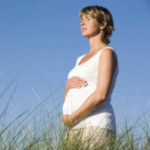 The first reported evidence of the Zika virus in the Americas came from Brazil’s northeastern region in 2015, with a surge of microcephaly (small brain and small head) cases in babies born to Zika infected mothers (Phillips, D., & N. Miroff, “Zika leaves a confusing trail across Americas,” The Wash Post, 10-26-16). Since 2015 the virus has spread to 58 countries. (Sun, L. H., The Wash Post, 1-17-17)
The first reported evidence of the Zika virus in the Americas came from Brazil’s northeastern region in 2015, with a surge of microcephaly (small brain and small head) cases in babies born to Zika infected mothers (Phillips, D., & N. Miroff, “Zika leaves a confusing trail across Americas,” The Wash Post, 10-26-16). Since 2015 the virus has spread to 58 countries. (Sun, L. H., The Wash Post, 1-17-17)
By 2016, U.S. health officials were alerting citizens to the potential threats of Zika virus in babies due to prenatal Zika virus exposure and letting them know that in adults symptoms of the Zika virus infection can include: fever, rash, joint pain, and conjunctivitis (pink eye) or no symptoms at all. (Sun, L.H., “CDC report tracks Zika defects in U.S.,” The Wash Post, 12-15-16)
As of 2017, although some Maryland residents have tested positive for Zika virus, they all were infected during travel to Zika-endemic areas as opposed to being infected from bites by local (Maryland) mosquitoes.
Further we present background, and general recommendations to help prevent Zika virus from reproducing in Maryland mosquitoes while also keeping ourselves and our environment healthy.
Click here to read full article
• • • • •
Pesticide Misinformation and the Public Part 2
Posted 6-14-17
 We begin our summer of awareness with “Pesticide Misinformation and the Public Part 2.” A reader of The Philadelphia Inquirer (P.I.) asked RCLA to comment on “Five Questions: From lobotomies to margarine, what scientists got wrong,” in the April 16, 2017 paper. In referring to Silent Spring this piece attributes to Rachel Carson the claim that “DDT causes children to suddenly die.” After carefully consulting Silent Spring and failing to verify such an association for DDT, we uncovered incidents involving similar tragic effects for another highly toxic insecticide. In our comments we present several possible explanations for how this misinformation about DDT might have occurred. To learn about the identity of the other highly toxic insecticide, additional misstatements concerning DDT in the piece as well as our discussion of this P.I. article’s implications for today, read our full “Part 2” report. Click here for complete text
We begin our summer of awareness with “Pesticide Misinformation and the Public Part 2.” A reader of The Philadelphia Inquirer (P.I.) asked RCLA to comment on “Five Questions: From lobotomies to margarine, what scientists got wrong,” in the April 16, 2017 paper. In referring to Silent Spring this piece attributes to Rachel Carson the claim that “DDT causes children to suddenly die.” After carefully consulting Silent Spring and failing to verify such an association for DDT, we uncovered incidents involving similar tragic effects for another highly toxic insecticide. In our comments we present several possible explanations for how this misinformation about DDT might have occurred. To learn about the identity of the other highly toxic insecticide, additional misstatements concerning DDT in the piece as well as our discussion of this P.I. article’s implications for today, read our full “Part 2” report. Click here for complete text
• • • • •
View From Rachel’s Window – March 2017:
Protecting Frogs’ Habitats for Their Services and Their Songs
Posted 3-15-17
From Rachel’s study window you can see the portion of her property that she wanted kept wild to serve as habitat for birds and frogs. It is from here in early spring that the “wilderness music” of frogs still arises out of the vernal pools and nearby wet places providing a sense of wonder as delightful to today’s families as it was to Rachel Carson 60 years ago.
Walking along the historic Chesapeake & Ohio (C&O) Canal towpath in late February of this year you may have been favored with hearing the voices of Wood Frogs and Spring Peepers (a kind of frog) resonating from the wetlands. They are considered to be “among the most ancient sounds of the earth”.
The remarkable Wood Frogs are unique in occupying a territory ranging from Georgia to the Yukon. However, along with other cold-blooded amphibians they confront multiple challenges including: habitat loss, contamination of available aquatic living sites, as well as lack of sufficient recognition by the public of their special contributions and of their need for better protection. Federal legislation the “clean water rule” passed in 2015 under the Obama administration that could help assure healthier living conditions for frogs and other aquatic creatures has recently come under fire and may soon be abolished or significantly weakened.
The 2015 “clean water rule” could provide future protection for small streams and wetlands nationwide depending on the support from many caring and concerned individuals. A 2017 spring of awareness and action by members of the public is needed now to defend the “clean water rule” and join with others who have championed it including environmental, recreational and sport fishermen groups. Click here for complete discussion
• • • • •
Pesticide Misinformation and the Public — Part 1
Posted 1-18-17
Pesticide misinformation taking place around us is not a new phenomenon. It was part of the challenge that prompted Rachel Carson to write Silent Spring. Today, it can appear in non-traditional forms, such as in an article from a group with a scientific-sounding name, or in a report by an organization claiming to be citizen-based and studying declines in bee populations.
Legislation based on grassroots efforts by citizens or involving “The Endangered Species Act” can counter misinformation and help educate the public about some hazardous aspects of chemical pesticides. Investigative journalists can contribute in-depth information to help further public awareness of questionable actions by chemical industry representatives seeking to protect their products. Click here for complete report
• • • • •
Twelve Important Things About Landscape Pesticides
Posted 1-18-17
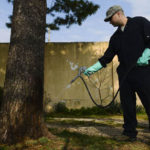 This overview is designed to help a home owner or interested citizen by providing some basic facts about landscape pesticides. It is intended to be used in conjunction with “Pesticide Misinformation and the Public — Part 1″
This overview is designed to help a home owner or interested citizen by providing some basic facts about landscape pesticides. It is intended to be used in conjunction with “Pesticide Misinformation and the Public — Part 1″
Click here for complete article
• • • • •
Rachel Carson’s World: In 1951 and 2016
Posted 11-14-16
In her 1951 “Words to Live By” piece Rachel Carson wrote:
“In these troubled times it is a wholesome and necessary thing for us to turn again to the earth and in the contemplation of her beauties to know the sense of wonder and humility. There is modern truth in the ancient wisdom of the psalmist: `I will lift up mine eyes unto the hills, from whence cometh my help.’”
In 2016 urgent reports predict grave dangers to wild creatures and their habitats unless we reverse the detrimental impacts of humans on our planet. Today the hills, valleys, streams and seas need our help to preserve ecosystems and biodiversity. Noted ecologists E.O. Wilson and Doug Tallamy have proposed global and local actions that we can take. For further discussion click here
• • • • •
Colorful blooms (purple, deep red, yellow, orange and pale pink) are flourishing in our Green Legacy Garden at midsummer
Posted 7-27-16
Colorful blooms (purple, deep red, yellow, orange and pale pink) are flourishing in our Green Legacy Garden at midsummer.
Click here for more about them and their popularity with visiting bees, butterflies and birds
• • • • •
A Garden is Dedicated to Rachel Carson on Her Birthday
Rachel Carson was born on this day in 1907. It is also the day chosen for dedicating a Green Legacy Garden intended as a safe habitat for plants, pollinators and feathered visitors as well as a tribute to Rachel Carson and the others who helped bring it about. Ground breaking took place in 2015 and planning started even earlier.
In accord with Carson’s preference for avoidance of hazardous chemical pesticides, the Garden is a chemical pesticide-free natural habitat.
Most plants in the Green Legacy Garden are native to the Mid-Atlantic area, where it is located. They can be counted on to provide flowers that benefit wildlife and bloom from early Spring thru late Fall.
It is not too early for those who admire Rachel Carson to start putting in place plans for a Rachel Carson Tribute Garden to be dedicated on May 27, 2017 which will be the 110th year since her birth.
Green Legacy Garden Plants in Full bloom on this day (5-27-16) include: False blue indigo (Baptisia australis), Foxglove penstemon (Penstemon digitalis) Salvia nemorosa “Caradonna”, Woodland sedum (Sedum ternatum), Blue-eyed grass (Sisyrinchium angustifolium), and Heartleaf foamflower (Tiarella cordifolia)
Click here for more about blooms in the Green Legacy Garden
• • • • •
PAST ARTICLES
“View from Rachel’s Window”
Mindful of Monarchs 07-06-16
Spring of Awareness and Action 2014 10-14-14
Monarchs in Maryland and Beyond 10-14-14
ABOUT RACHEL CARSON
“The more clearly we can focus our attention on the
wonders and realities of the universe about us,
the less taste we shall have for destruction.”
—Rachel Carson
• • •
Activities/Actions
 Announcement of 2024
Announcement of 2024
Wonder Contest Winners
RCLA appreciates all who submitted entries to our 2024 Rachel Carson Intergenerational Sense of Wonder/Sense of the Wild Contest (Wonder Contest) and congratulates the 62 participants on the 27 winning teams. They are listed by Theme, Category, and Award Designation (First Place, Second Place, Honorable Mention). Click here for the full list of the 2024 Wonder Contest’s winning entries.
Click here for the full list of the 2023 Wonder Contest’s winning entries.
• • • • •
Selected 2021 Sense of Wonder/Sense of the Wild Contest Winners
Six Winning Entries from RCLA’s 2021 Rachel Carson Intergenerational Sense of Wonder Sense of the Wild Contest as described in the February 2, 2022 “RCLA Friend” letter. Click here to read more
• • • • •
Announcement of 2021
Wonder Contest Winners
RCLA appreciates all who submitted entries to our 2021 Rachel Carson Intergenerational Sense of Wonder/Sense of the Wild Contest (Wonder Contest) and congratulates participants on the 57 winning teams. They are listed by Theme, Category and Designation (First Place, Second Place, Honorable Mention). At the very end of of the winners’ list you can read our Wonder Contest Judge’s 2021 General Comments that apply to all winning entries. Coming soon will be the full text of four or more 2021 winning entries. Click here for the list of 2021 Wonder Contest winning entries and Judge’s Comments.
• • • • •
A Correction to the letter “Remembering Silent Spring and the Woman Who Helped Rachel Carson Complete It”
We apologize for the unintentional deletion of the word “chemicals” from the Paul Brooks quotation appearing directly after “First a few words about Silent Spring from literary sources.” The complete paragraph with corrected quotation follows:
“Rachel Carson’s landmark book, “by awaking us to a specific danger — the poisoning of the earth with chemicals — has helped us to recognize many other ways (some little known in her time) in which mankind is degrading the quality of life on our planet.” (Paul Brooks, writer and Carson’s editor)
• • • • •
2020 Rachel Carson International Sense of Wonder / Sense of the Wild Contest Winners
Click here for list of winning entries
• • • • •
2019 Rachel Carson International Sense of Wonder / Sense of the Wild Contest Winners
Posted 1-31-20
The winners are presented in 3 groups. I. SENSE OF WONDER, II. SENSE OF WONDER / SENSE OF THE WILD, III. SPECIAL RECOGNITION.
Click here for full listing of winning entries
• • • • •
RCLA’s Review of the 2019 Rachel Carson Open House
Posted 12-17-19
In the words of an enthusiastic participant, the recent Rachel Carson Open House held on Saturday, May 4, 2019 provided, “… an integration of science and art that made so much sense… stimulating subjects to ponder – along with poetry, music, healthy organic food and gardening – what a worthwhile way to learn!”
There were riveting speakers at the event: Dr. John Losey, (Cornell University Professor of Entomology), Maya von Rossum (Delaware River Keeper, Attorney and Author of The Green Amendment), and Andrea Barnet (Author of Visionary Women).
Thought-provoking information from our speakers is being offered in two installments. Part 1, is focused on the presentation by Dr. John Losey (available now by a link below). Part 2, includes the presentations by Maya von Rossum and Andrea Barnet (available soon).
Part 3, Gives a run down on the event’s special features including poetry, music and other treats, as inspired by this year’s theme “A Spring of Green Awareness.” (available soon)
Click here for the report on Dr. Losey’s talk along with the Commentary by RCLA linking Trump administration policies to potential adverse impacts on innovative efforts of scientists.
• • • • •
Information about Bi-Partisan Legislation to Help Protect Animals and People — US HR 2471 — the Chemical Poisons Reduction Act of 2019
Posted 12-24-19
In our December 25, 2019 letter to Friends of RCLA, accompanied by “The Christmas Coyote” we mentioned recently proposed legislation, the Chemical Poisons Reduction Act of 2019 (US HR 2471).
Note: If you did not receive our December 25, 2019 letter please let us know and we will make sure that you are sent a copy along with “The Christmas Coyote.”
• • • • •
Pollinator Garden Observations:
August 2019
Posted 8-29-19
On the Carson House grounds close by the site where Silent Spring was written there is now a pesticide-free spot frequented regularly during late summer by clouds of butterflies, solitary native bees, other beneficial insects, as well as catbirds, wrens, and goldfinch.
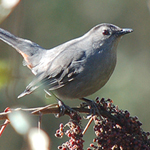 This Pollinator Garden with a growing season from April through October, offers a succession of bird/butterfly/bee-friendly native plants that contribute nectar, pollen, seeds, berries, and habitat for our special wild guests. It is organically-maintained and encircled by a low fence to exclude predators and browsers.
This Pollinator Garden with a growing season from April through October, offers a succession of bird/butterfly/bee-friendly native plants that contribute nectar, pollen, seeds, berries, and habitat for our special wild guests. It is organically-maintained and encircled by a low fence to exclude predators and browsers.
For details about the amazing number of wild winged visitors and which flowers they favored in late summer 2019 click here
• • • • •
For Rachel Carson’s Birthday
May 27, 2019
A Remembrance
From Pesticide Applications in a Maryland County (in 1959 and 2019)
To the Planet-Wide Dual Crises Facing Us Today —
Rachel Carson’s Words Have Resonance
Posted 5-24-19
• • • • •
A Sampling of Winning Entries with the “Sense of Wonder” Theme from the 2018 Rachel Carson Intergenerational Contest
Posted 2-16-19
In her 5th book, The Sense of Wonder, Rachel Carson wrote that she wished for every child, “a sense of wonder…reflecting the joy, excitement and mystery of the [natural] world we live in…and the companionship of at least one adult who can share it…”
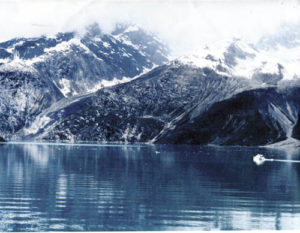 As Rachel Carson pointed out, the “sense of wonder” of older individuals (parents, grandparents, teachers) can encourage, educate and enrich the experiences of the young. At the same time, the enthusiasm for nature in the young can enable older participants to appreciate and re-connect with familiar experiences by seeing them through fresh, eager eyes.
As Rachel Carson pointed out, the “sense of wonder” of older individuals (parents, grandparents, teachers) can encourage, educate and enrich the experiences of the young. At the same time, the enthusiasm for nature in the young can enable older participants to appreciate and re-connect with familiar experiences by seeing them through fresh, eager eyes.
Here are 4 award-winning “sense of wonder” theme entries from our 2018 Contest. These were created by intergenerational teams, and show imaginative writing, sensory detail, and strong imagery. They are
- “In My Forest,” (A joyful poetic celebration of Nature’s power to liberate the spirit.)
- “The Rainbow of Life,” (Enchanting and life-affirming – a rhapsody of wonder.)
- “one small step into the woods, one giant leap towards nature,” (A heartwarming story of a teen’s unexpected benefit from a camping trip with his grandfather.)
- “The Wonders of Our World,” (A powerful description of the immense awe that comes with experiencing Alaska’s Glacier Bay for the first time.)
Click Here to view the complete text for all four entries
• • • • •
Report on the 2018 Rachel Carson Open House
Posted 8-7-18
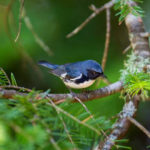 On May 5, 2018 the annual Rachel Carson Open House was held at her former home, the birthplace of Silent Spring — a National Historic Landmark Site.
On May 5, 2018 the annual Rachel Carson Open House was held at her former home, the birthplace of Silent Spring — a National Historic Landmark Site.
For those not at the 2018 Open House we offer a report of the event, in two installments. Part 1 is an account of Dr. Christopher J. Whelan’s talk, “Why Birds Matter,” (see “Introduction” and link below). This is followed by “RCLA’s Addendum: Avian Ecosystem Services in 2018 and Actions For Birds.”
Part 2, available soon, will include details on event features as well as our account of Michele Colopy’s talk, “The Native Bee Advantage.”
Introduction to “Why Birds Matter”
In the last chapter of her book Silent Spring, published in 1962 Rachel Carson gave examples of insects, bacteria, viruses and mammals as providing effective biological control of pest insects and therefore as alternatives to the use of chemical pesticides.
In his 2018 presentation Dr. Whelan gave examples of birds as “effective and resistance-proof biological insecticides.” He further stated that: “Birds can control insect pests in agricultural ecosystems, precluding the use of harmful pesticides.”
The above observations and more by Dr. Christopher Whelan are found in RCLA’s account of his 2018 Open House presentation. Click here for full text
• • • • •
RCLA ACTION ALERT
Migratory Birds At Risk From A Preventable Death Threat
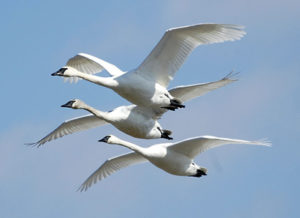 Three neighboring nations (US, Canada and Mexico) created a way to protect the birds of North America from human-generated threats under the 1918 Migratory Bird Treaty Act (MBTA). Since the 1970s all U.S. administrations have enforced the MBTA. Now in 2018, however, our migratory birds appear to be threatened with death from man-made industrial hazards. Why? Trump Administration appointees recently eliminated a major, bird-protective provision of the MBTA. They cancelled corporate liability (enforced by fines) for bird killings that unintentionally accompany certain industry-related hazards. Such threats include open industrial oil waste pits that could kill over a million birds per year. This damage is largely preventable by covering the oil waste pits with netting to keep birds from landing. Previous administrations using the MBTA as leverage had successfully negotiated net covers for waste pits with industry. Without legal penalties and fines for companies that fail to adopt basic safety steps — bird deaths will inevitably rise. Authorizing conditions known to cause avian suffering and death clearly violates the spirit of the MBTA and contributes to depriving our nation of a valuable natural asset and source of ecosystem services to the public. Friends of birds who want more details and suggested ways to help, can click here for particulars
Three neighboring nations (US, Canada and Mexico) created a way to protect the birds of North America from human-generated threats under the 1918 Migratory Bird Treaty Act (MBTA). Since the 1970s all U.S. administrations have enforced the MBTA. Now in 2018, however, our migratory birds appear to be threatened with death from man-made industrial hazards. Why? Trump Administration appointees recently eliminated a major, bird-protective provision of the MBTA. They cancelled corporate liability (enforced by fines) for bird killings that unintentionally accompany certain industry-related hazards. Such threats include open industrial oil waste pits that could kill over a million birds per year. This damage is largely preventable by covering the oil waste pits with netting to keep birds from landing. Previous administrations using the MBTA as leverage had successfully negotiated net covers for waste pits with industry. Without legal penalties and fines for companies that fail to adopt basic safety steps — bird deaths will inevitably rise. Authorizing conditions known to cause avian suffering and death clearly violates the spirit of the MBTA and contributes to depriving our nation of a valuable natural asset and source of ecosystem services to the public. Friends of birds who want more details and suggested ways to help, can click here for particulars
• • • • •
Rachel Carson Birthday Message
May 27, 2018
Posted 5-25-18
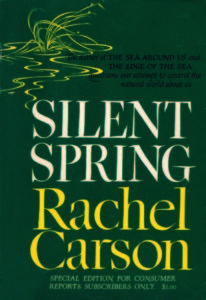 Rachel Carson’s birthday on Sunday May 27, 2018 comes during a time when a war on the environment and human health is being pursued by the Administrator of the US Environmental Protection Agency (EPA). It is noteworthy that historians attribute this Agency’s founding in no small measure to the influence of Rachel Carson and her book, Silent Spring.
Rachel Carson’s birthday on Sunday May 27, 2018 comes during a time when a war on the environment and human health is being pursued by the Administrator of the US Environmental Protection Agency (EPA). It is noteworthy that historians attribute this Agency’s founding in no small measure to the influence of Rachel Carson and her book, Silent Spring.
Since our nation appears to be going backward from protecting the health of American citizens and the environment to an earlier time possibly even before the EPA existed, it seems instructive to consider similarities between then and now as well as a recommendation from Rachel Carson.
From the mid 1940s until 1970, an apparent conflict of interest existed with respect to regulation of chemical pesticides by the US Department of Agriculture (USDA) administrators. During this period the USDA was responsible for both promoting and regulating pest control agents such as DDT, dieldrin, chlordane, parathion, etc. This conflict of interest condition resulted in inadequate protection of public health and the environment from pesticides’ hazards. Various dangers existing under the pre-EPA regulatory arrangement were noted in Silent Spring. In 1970 the USEPA was founded and given responsibility for pesticide regulation (not promotion) as well as other regulatory roles.
Under present EPA Administrator Pruitt an aggressive deregulatory push apparently intended to benefit the regulated industry has been taking place leading to a current conflict of interest -type situation.
More actions are anticipated in the future as Administrator Pruitt tilts the balance toward significantly decreasing the costs to industry and away from enforcing USEPA regulations intended to protect the environment and human health.
Rachel Carson’s recommendation to those who would endeavor to protect human health and the planet is taken from her publication, “A New Chapter to Silent Spring:”
We must remain vigilant, we must continue to challenge and to question…As you listen to the present controversies [in 2018 concerning pesticides, climate change, regulatory actions, GMOs, etc]…ask yourself‚—Who speaks?—And Why?
For details about Rachel Carson’s House where she wrote Silent Spring, click here
• • • • •
Report on RCLA Intergenerational Bird Walk around Cash Lake at Patuxent Research Refuge
Posted 11-5-17
Introduction
On Sunday, November 5th the RCLA Intergenerational Bird Walk took place as scheduled at the National Wildlife Visitor Center section of the historic Patuxent Research Refuge, an area established in 1936 by President Roosevelt to conduct wildlife research and to serve as a refuge for birds and other wild creatures.
We were hoping to see many year-round resident birds as well as a number of winter migrants at the beautiful, protected, natural area around Cash Lake. The forest with its stunning fall colors beckoned through the misty light rainfall as we took to the trail. The steady light rain had not been previously predicted. This no doubt prevented participation of several others we had been expecting to join us. (This Sunday was actually the alternative “rain date” for the walk which had been planned for the previous week).
Proceeding around the lake, our little band of birders spent the next 2 hours enthralled by an unexpected treasure trove of avian species (27 total identified). These birds were calling, singing, flying, perching, diving and feeding as we looked on.
We observed and appreciated a number of remarkable bird species that Sunday morning, making our walk at the Patuxent Research Refuge’s Cash Lake site a most memorable experience!
For details about the Bird Walk and our list of species click here
• • • • •
A Late Summer Place for Wonder: The Carson House Pollinator Garden
Posted 8-30-17
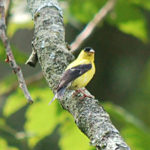 In 1958 Rachel Carson began gathering material on chemical pesticides for what became her renowned Silent Spring. She took precious time from her work to observe the nature she loved through the wide windows of her Berwick Road study. In contemplating how best to approach the task that lay before her Carson wrote to a friend, “…I think there is still a place for wonder.”
In 1958 Rachel Carson began gathering material on chemical pesticides for what became her renowned Silent Spring. She took precious time from her work to observe the nature she loved through the wide windows of her Berwick Road study. In contemplating how best to approach the task that lay before her Carson wrote to a friend, “…I think there is still a place for wonder.”
This year on the grounds of her home on Berwick Road as a living tribute to Carson and her life-long high regard for nature, there is a two-year old pollinator garden consisting primarily of perennials native to the region. It offers food, water and a pesticide-free sanctuary for some of our most imperiled insects. It attracts pollinators, birds and beneficial insects and can evoke a sense of wonder in those human observers who walk its pathways. The full report identifies plants blooming in late summer and which of them are most favored by various visiting pollinators.
We hope that in the months to come there will be times of wonder and special places for wonder reflecting Carson’s vision and message in the busy lives of each of our RCLA friends and supporters.
• • • • •
Celebrate Rachel Carson
(May 27, 1907-April 14, 1964) During Her 110th Birth Year
Posted 5-25-17
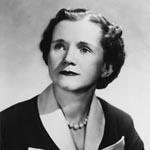 Rachel Carson’s 110th birthday anniversary this year finds more members of the public showing concerns about environmental health and the future of life on earth. The unease of a great many Americans reflects plans by the current administration to reduce funds for environmental protection and scientific research as well as to relinquish protection for certain wild lands currently shielded from natural resource exploitation. Many concerned citizens no longer feel comfortable trusting in “so-called authorities” to take care of things. It seems like a good time to invoke Rachel Carson’s prescient 1962 observation, “A sense of personal responsibility is what we desperately need.” (“The Gentle Storm Center,” Life Magazine, 10-12-62).
Rachel Carson’s 110th birthday anniversary this year finds more members of the public showing concerns about environmental health and the future of life on earth. The unease of a great many Americans reflects plans by the current administration to reduce funds for environmental protection and scientific research as well as to relinquish protection for certain wild lands currently shielded from natural resource exploitation. Many concerned citizens no longer feel comfortable trusting in “so-called authorities” to take care of things. It seems like a good time to invoke Rachel Carson’s prescient 1962 observation, “A sense of personal responsibility is what we desperately need.” (“The Gentle Storm Center,” Life Magazine, 10-12-62).
• • • • •
Unveiling of Panel Honoring Rachel Carson at Glover Archbold National Park in Washington, DC
Posted 10-7-16
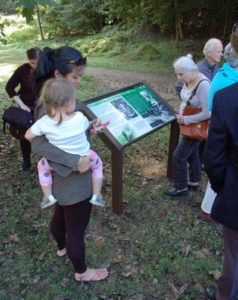
Glover Archbold National Park
visitors check out a marker
honoring Rachel Carson
and park namesakes
Charles Glover and Anne Archbold
after its unveiling on Tuesday,
September 27, 2016.
Photo Credit: John A. Bray
A joyous celebration of Rachel Carson under the towering Tulip Poplars and Oaks on September 27, 2016.
The attractive panel is situated on a grassy slope near the Park’s trail access on the south side of Reservoir Road. It provides information on the historical importance of Rachel Carson through her book Silent Spring, a groundbreaking work released in 1962 that warned a then unknowing citizenry about problems with chemical pesticides. Click here for full article
• • • • •



